

Larry Reyes: The flyin' Hawaiian and other stories
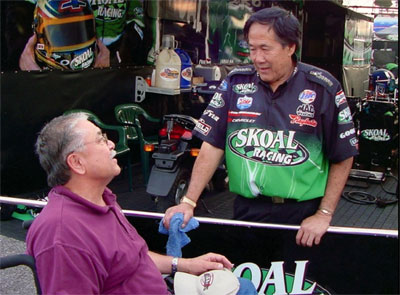
Former Hawaiian driver Larry Reyes, left, caught up with his old car owner, Roland Leong, a few years ago. The two made history together in the early 1970s and have remained friends.
|
As a reporter, one of the great – if by "great" you really mean "sure to open up new leads to chase down that will suck away those last precious hours you had designated for hygiene, sleep, or food" -- things about working on a big story that requires a lot of interviews is that I'm a sucker for a good side story. I mean, there I am, barreling down the Highway to Deadline when up pops the signpost that says, "Oooh, turn here instead, and let's explore this road, too."
It has happened to me – as I'm sure it would to many of you – while leafing through decades-old issues of National DRAGSTER. I unfold the yellowing pages gingerly. There I go, knowing exactly what I'm looking for, trying to block out anything else, and up jumps a juicy headline or interesting photo, and the next thing I know, I'm eyeballs deep in reading and taking mental notes on a completely unrelated subject. It's kind of the same phenomenon that happens when you start clicking those "related videos" links on YouTube and start watching drag racing, and before you know it, you're watching cheese-log rolling from Finland.
It happens, too, in interviews with those secondary players to my story, when I'm in single-minded pursuit of The Quote, that great sound bite that fits perfectly and complements my story. I'm on a tight deadline and pick up the phone and just want what I want and need. I can accomplish this effortlessly when I go to the store; I call it "guy shopping." I know exactly what I want, on which aisle and even which shelf it's located, how much it costs, and how soon I can get home with it. I don't need to compare colors or prices or brands. I'm in, I'm out, and that's it. I am a freaking commando when it comes to shopping.
But put me in a room or on the phone with some connection to our sport, and I go all soft and pliable and all ears. That’s a pretty long preamble to today's column, but I just thought I'd share my curse with you. I know; it's a burden I must carry.
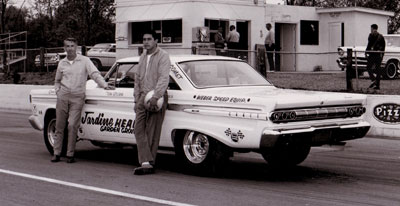
(Above) Larry Reyes' career as a hired gun began behind the wheel of Tom Sturm's A/FX Comet, but he soon caught the eye of Larry Coleman and Bill Taylor and began driving their early Funny Car, The Kingfish (below).
|
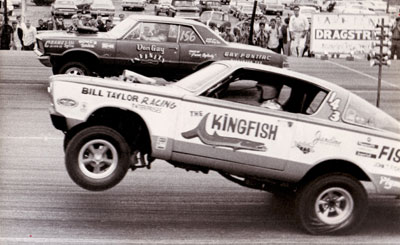 |
As I mentioned here a few weeks ago when I was already deep into it, I was working on the Roland Leong story to end all Roland Leong stories, the holy grail of Hawaiian lore. I had hoped to track down all of the living members of the I Drove for Roland Club and get their stories of their years (or, in the case of some, months) with drag racing's most storied car owner. I got to talk to a good number of them, among them Larry Reyes, the first Hawaiian Funny Car driver; Leong couldn't remember how he and Reyes first got together, so he gave me Reyes' cell number, and I spent an enjoyable half-hour on the phone with the likable former driver.
Most people know of Reyes only for his Winternationals aerobatics at the 1969 season opener, but Reyes' road to the Hawaiian was a long and colorful one. His first trip down the quarter-mile was at fabled Santa Ana Drags in 1955 in his mother's Volkswagen. By 1964, he had his own Plymouth Super Stocker and earned his first hired ride a year later in Tom Sturm's 427-powered A/FX Mercury Comet. In their travels, he met Larry Coleman and Bill Taylor, partners in a string of Memphis-area transmission-repair shops and owners of Lakeland Drag Strip. Before long, they had hired Reyes into the saddle of the first Kingfish Barracuda. Reyes left his SoCal life and moved to Memphis.
Built by Memphis' John Albright around a tube chassis, the first Kingfish was all steel. Even after the team switched to a fiberglass body, the car retained a stock-appearing wheelbase and fully functional doors. Although Taylor fed the new 426 Chrysler Hemi engine a light 28 percent diet of nitro, that still led to clockings in the eight-second zone at more than 160 mph. By 1967, the team had adapted the flip-top look pioneered by Don Nicholson and others and fitted the shell over a state-of-the-art Logghe chassis, and their reputation began to spread, but when a young well-heeled racer named T.B. Smallwood looked to splurge with his trust fund, Taylor sold him The Kingfish car and the name along with it.
Taylor and Reyes were back the next year with the Logghe-chassised Super Cuda that even on the miserly 55 percent that Taylor tipped out of the can was still a major draw and a hard runner, winning events such as the Capitol Raceway Supercharged King of Kings Invitational, Detroit Dragway's Super Stock Magazine Funny Car Invitational, and the year's most prestigious event, the Super Stock Magazine Nationals at New York National Speedway. They capped their year win a win at the AHRA Drag World Championships in Kansas.
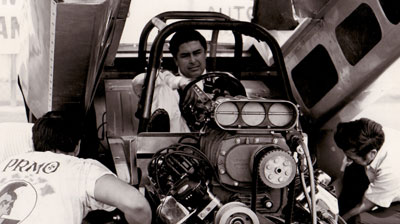
Reyes says he had a bad feeling about the first Hawaiian Funny Car the minute he sat behind the wheel. Note the typical square Logghe cage and the round steering wheel of the era.
|
About this time, Reyes bought his own Funny Car, a Don Hardy-built Barracuda, and, like the pioneers of old, headed west on his own. Reyes was at the counter in Keith Black's shop in South Gate, Calif., which was always a hub of activity, when he met Leong, who was spending a small fortune to build the first Hawaiian Funny Car.
"I knew who Roland was and had seen him race but had never actually met him," recalled Reyes. "He came up and introduced himself to me. He told me that he was building a Funny Car, which I already knew because everyone wanted to drive it. He said, 'I was wondering if you'd be interested in driving it.' I told him that I had a ride already but I would think about it. He called me a week or two later and asked me if I'd thought about it, and I decided to do it. The Super Cuda had a big history, but I was looking to do something a little different. Plus I had my own Funny Car, but it was creating some friction with Bill's bookings with his car. I had been friends with Bill for a long time, and it caused so much conflict that it wasn't worth losing our friendship over, so that's why I decided to go with Roland. It brought peace to the family. I heard later that Gene Snow had recommended me to Roland, but there were a lot of guys who were good-naturedly mad at me, guys like Steve Bovan who told me they'd turned in résumés to Roland and everything."
With just a few shakedown runs, the team headed to Pomona for the 1969 season-opening Winternationals, but Reyes already has misgivings.
 "As soon as I got into that car, I didn't like it," he told me. "I said to myself, 'What have I done?' The car was too big, and I couldn't see out of it. The braking system didn’t work; it would steer or turn. At Pomona, I had to stage in high gear because I couldn't hold the car on the line in low."
"As soon as I got into that car, I didn't like it," he told me. "I said to myself, 'What have I done?' The car was too big, and I couldn't see out of it. The braking system didn’t work; it would steer or turn. At Pomona, I had to stage in high gear because I couldn't hold the car on the line in low."
Launching in high gear cost e.t., plus the car was a spooky handler during his qualifying runs, but Reyes nonetheless gutted it out and made the field on the bump spot with an off-pace 8.33; by contrast, Tom McEwen was at the head of the pack with a 7.79. Reyes drew Mike Hamby in round one and had just collected the win light, 8.14, 181.45 to 8.58, 167.91, when things went really bad.
 I've read conflicting accounts as to what happened, some blaming tire pressures and others the less-than-aerodynamic body, but the end result was that the car got loose in the lights, and the rear end came around. Reyes had avoided a nearly similar incident in qualifying by quickly deploying the chute, but this time, there was no saving the car. It swapped ends and became airborne and flew an estimated 200 feet through the Pomona shutdown area. It landed on its lid, slid for a moment on its roof, then rolled a half roll and landed on all four wheels and jettisoned the body into the SoCal sky. Reyes was, as Bond would say, shaken but not stirred.
I've read conflicting accounts as to what happened, some blaming tire pressures and others the less-than-aerodynamic body, but the end result was that the car got loose in the lights, and the rear end came around. Reyes had avoided a nearly similar incident in qualifying by quickly deploying the chute, but this time, there was no saving the car. It swapped ends and became airborne and flew an estimated 200 feet through the Pomona shutdown area. It landed on its lid, slid for a moment on its roof, then rolled a half roll and landed on all four wheels and jettisoned the body into the SoCal sky. Reyes was, as Bond would say, shaken but not stirred.
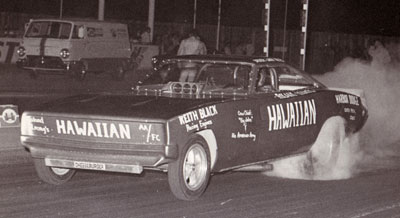
(Above) A few months after taking flight in Pomona, the Hawaiian returned with a mini Charger body. Despite the crude lettering and lack of paint, Reyes and Leong won a trifecta of races in the car's return. (Below) From right, Leong, Reyes, OCIR track manager Mike Jones, Keith Black, and John Mazmanian.
|
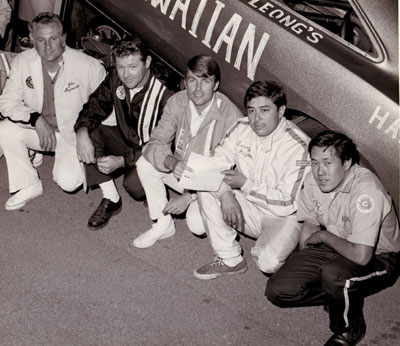 |
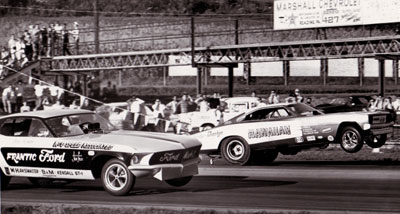
Despite its absence from the national event tour for the remainder of the 1969 season, the new Hawaiian was a hit everywhere it went, thanks to aerial antics like this against "Rapid Ron" Rivero's Frantic Ford at Maple Grove.
|
Although the body was toast, surprisingly the rest of the car suffered very little damage. Leong and company went back to the drawing board and came up with the mini Charger body, essentially narrowing the body by 6 inches, shortening it by 16, and chopping 2 inches off its height. Leong added front and rear spoilers for additional stability. The car, with crude shoe-polish lettering, made a spectacular return to the quarter-mile in late May.
"We built the mini Charger, and the first weekend out, there were three big races in Southern California, and we decided to run them all," recalled Reyes. "We won at Irwindale for $1,500 the first night and beat the Freight Train for another $1,000 that night, then we went to Orange County and beat everyone again and won $2,500 more. We went to Carlsbad the next day and won there, too. That was a big achievement for anyone, and that money meant a lot to us. Roland told me, 'Man, you saved us,' because we were hurting for money, and I told him, 'No we helped ourselves.' We won a lot of races with that car."
The mini Charger body was not legal for NHRA competition, so the Hawaiian match raced the remainder of the year before returning to the NHRA tour in 1970 with a legal body. Of course, one year after their crash, Leong and Reyes returned to the Winternationals and won the race, then, instead of hauling their car clear across the country, agreed to run a second car for Candies & Hughes at the Gatornationals, which led to the first all-team final, in which Leonard Hughes "beat" Reyes on a holeshot in a race that was decided before the two cars staged. Reyes was in the team's battle-tested '70 car, and Hughes in the new car.
"They asked which one I wanted, and I told them I'd take the old one because I was bad about wrecking new cars," Reyes said, "but in the staging lanes before the final, they told me I had to let the new car win because they had a sponsorship coming if the new car would win. I hated doing it, but I sat on the starting line when he left, then shut it off. The car would have probably run a 6.95.
"Paul Candies to this day tells me that he regrets doing that because that car could have been the first one to run in the sixes that day," said Reyes.
Reyes stayed with Leong until just before the Nationals, when they parted company and Pat Foster took over.
"I just didn’t like traveling," admitted Reyes. "Roland kind of wanted to go a different way, and there were no hard feelings; still aren't. He's been a good friend over the years. I had a good time and learned a lot."
Reyes reunited with Taylor at the end of the 1970 season and competed at the new Supernationals at Ontario Motor Speedway, then opened his 1971 campaign with a one-shot deal behind the wheel of "Big John" Mazmanian's Barracuda at the Winternationals, where they were defeated in round two.
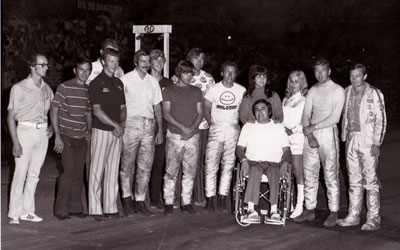
Reyes' pals rallied around him after he was paralyzed in a racing accident in July 1971 and held a benefit race for him at U.S. 30.
|
Reyes returned to Memphis and reunited with the Coleman-Taylor team on a new Super Cuda. It was in this car, at a match race in Norwalk in June 1971, that Reyes' driving career would come to an abrupt end. The car blew a tire at speed and crashed heavily, paralyzing Reyes. Although Reyes made some physical gains with hard work in rehab, a wheelchair became his lifelong ride. The love and admiration of those in the sport for Reyes was obvious at a benefit race held two months later at U.S. 30 in Gary, Ind., where about $27,000 was raised to assist with Reyes' medical bills.
Although Reyes made a brief return to driving in the early 1990s with a Super Gas Vega equipped with hand controls, his legacy in the sport had already been cemented, his place in history assured.
"I have no regrets about anything that happened," he told me. "I lost a lot of friends in those early days, but I made it through and have had a good life."



















































